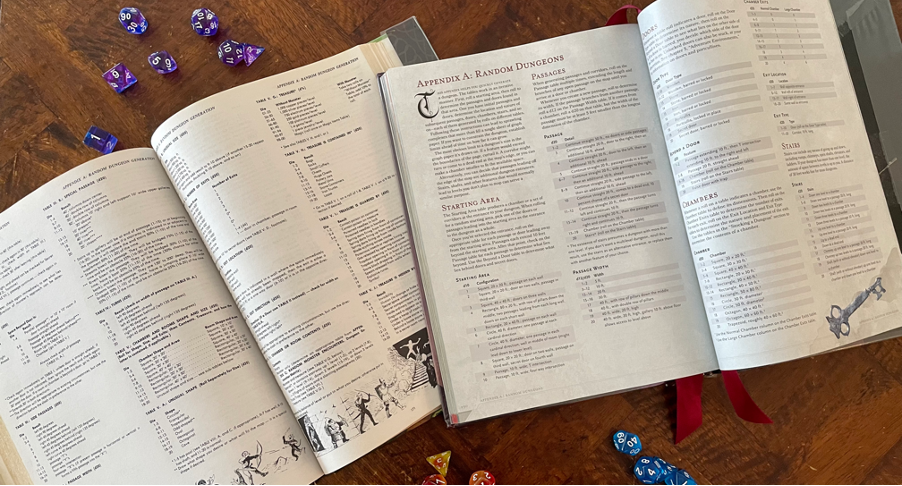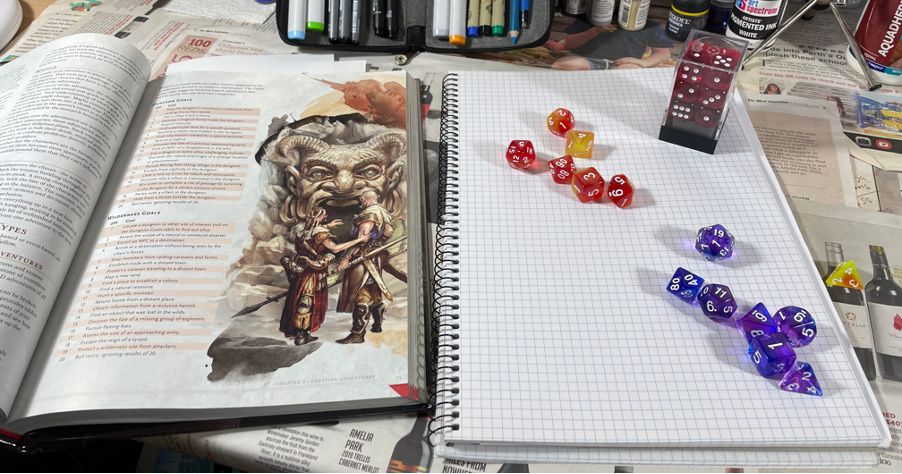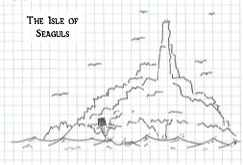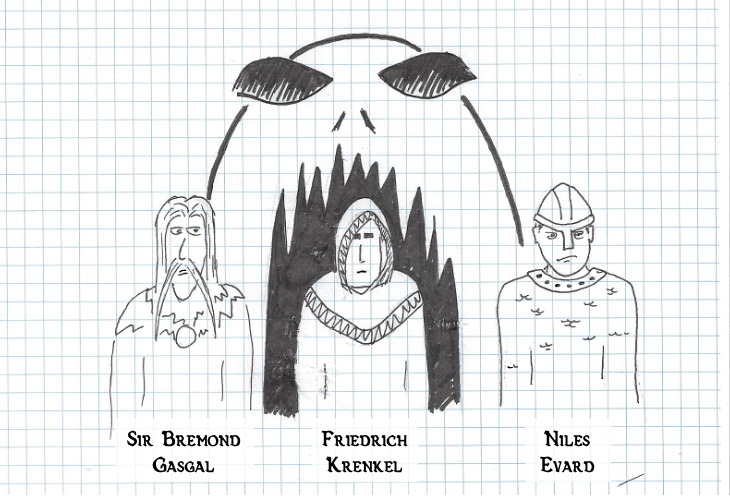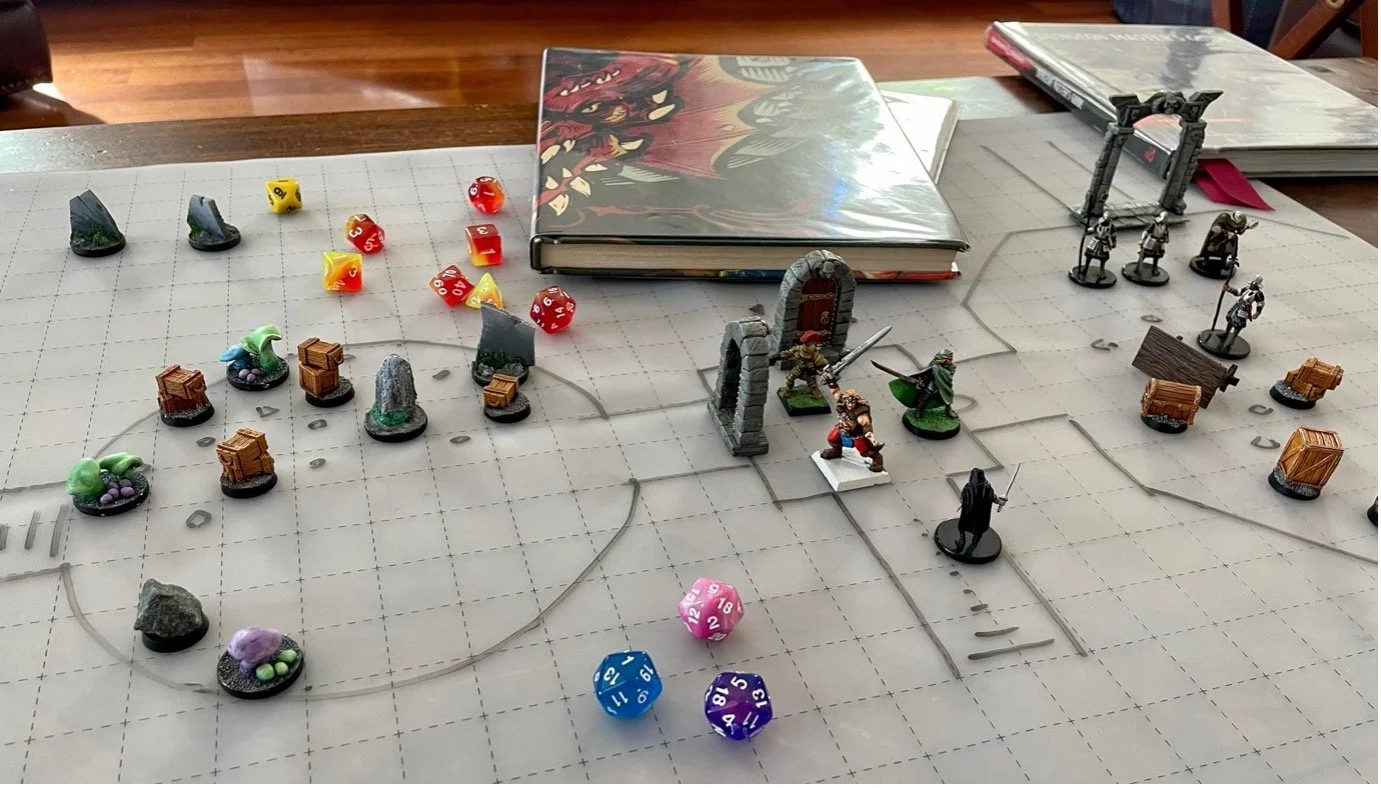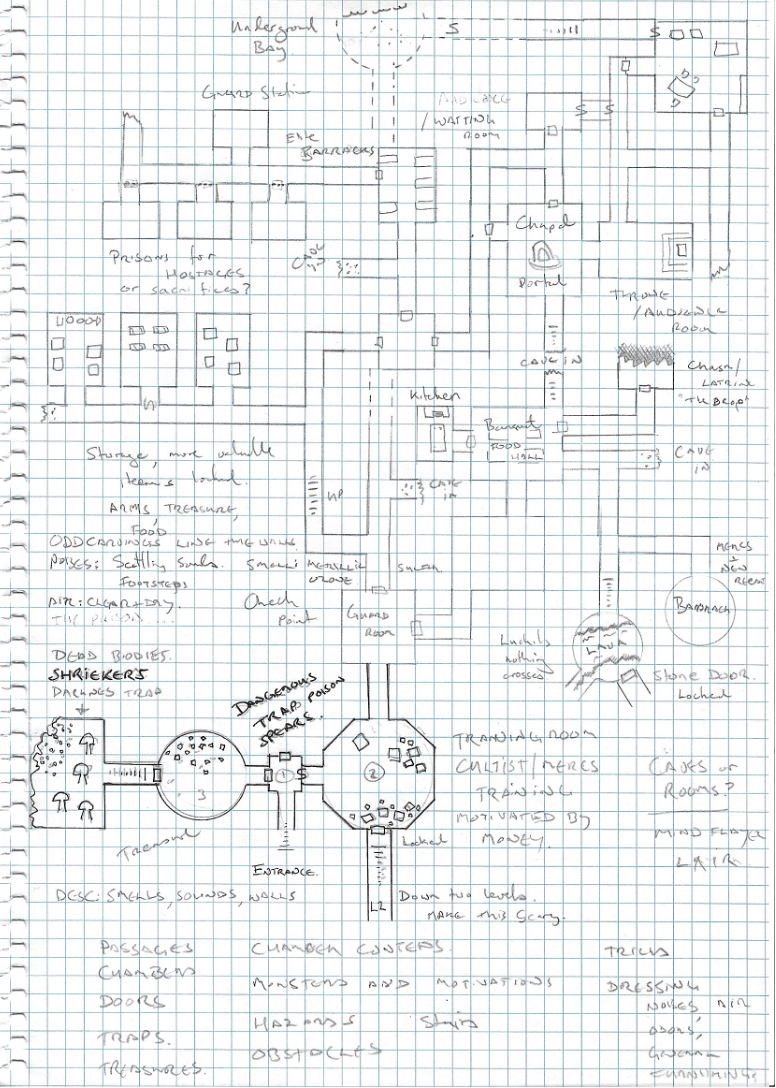Adventures in Adventure Design
Say hello to our newest guest writer! Ten-year-old Mark got a D&D basic set from his Grandfather… but couldn’t understand where the board or pieces were. So his poor dad stepped in and DM’ed Mark’s first game. It was full of spiders, stirges, and skeletons. It was awesome! Since then it’s been a hobby that brings people together, makes spaces to create, and is an outlet from a hectic professional life. Today, Mark plays with his friends and his three boys, continuing what his father and grandfather started.
Where do adventure designs come from?
Mine come from books, movies, video games, dreams, mythology, conversations, and half-forgotten history lessons. I would like to create more exciting adventures and stretch beyond these. I ask myself: where else could adventure designs come from? How could I create more interesting adventure designs? Where can I get new inspiration beyond the media I’ve consumed?
And then I remembered random dungeon generators. The Tome of Adventure Design (Kickstarter) has comprehensive adventure random tables; Mothership has a great dice-based random spaceship generator, and Dungeons & Dragons has Appendix A. Appendix A is a random dungeon generator that originally appeared in the AD&D Dungeon Master Guide in 1979. What I didn’t realise is that my 5e Dungeon Master’s Guide also has an Appendix A. It also has several chapters on adventure design. Let’s start there.
A tale of a Dungeon Master’s Guide and a Dungeon Master’s Guide 35 years apart | Credit: Mark Nold
What are we going to need?
Your Dungeon Master’s Guide.
A fist full of dice (multiple d10s and d20s).
Graph paper, pencils, rulers, an eraser, and a pen.
Bookmarks. Lots of bookmarks. Lots and lots of bookmarks.
A little tomb of horrors waiting to be created | Credit: Mark Nold
Two parts of creating an adventure from the 5e DMG | Credit: Mark Nold
How does it work? The actual overall process isn’t very prescriptive, so I’ve tried to stitch the guidelines and table together into two parts. Each section can be run independently and in any order. To make a complete adventure I’ll cover both.
Part 1 : Background to Adventure
In chapter 3 in the Dungeon Master’s Guide it's called “Creating Adventures”. The DMG splits adventures into two types: Location-Based Adventures and Event-Based Adventures. Ours will be location-based, these can be Dungeons or Wilderness. We’ll have a Location-Based Adventure which is a Dungeon, We will also assume this adventure is for 1st to 4th level party. Let’s get rolling!
Event Based Adventure
Tables and Rolls
Dungeon and Other Goals: DMG p.72-73 roll a d20 and d12.
Rolled a 16 “Discover why a villain is interested in the dungeon”
I like this first goal of finding out why the villain is interested in the dungeon. Sounds like a great start to a campaign.
… and a 11 on the option table “Seize control of a fortified locations such as a fortress, town, or ships”
We’ll ignore this optional goal for now.
The next step in a location-based adventure is to identify important NPCs. This helps you define the villain; ally or allies; and the player characters’ Patron.
Tables and Rolls
Identify Important NPCs
These tables helped me define some of the forces behind the adventure.
These tables helped me define some of the forces behind the adventure.
Rolled a 9 which means the Villain is a Humanoid Cultist.
This Cult Leader is up to something in the dungeon. This leader will need development.
Rolled a 12 which means there is a villain posing as an ally.
Somehow a double agent will infiltrate the party. Is it the Patron? Or their help?
Rolled a 10 identifies the PC’s patron as some sort of Sage.
A wise sage directing the PCs. Ideal. They’ll stay in the background.
I’m tempted now to flesh out the NPCs, but I decided to wait and understand the story beats and the location itself. The location is a key character in our story and will influence who the goals of the NPCs.
Tables and Rolls
Adventure Introduction & Climax
Adventure Introduction and Climax: DMG p.74-75 roll a d12 and another d12.
This helps define the main beats of the story. How does it start? How does it end?
Rolled a 8 which “An NPC the characters care about needs the to go the Adventure Location”
Simple. This is broad but it could be the Sage.
Rolled a 4 “The adventurers race to the site where the villain is bringing a master plan to its conclusion, arriving just as that plan is about to be completed”
This ties in well with the overall goal for the dungeon adventure of “Discover why a villain is interested in the dungeon”. I also like the time pressure element.
Now we need to understand the location and start to build the dungeon. Chapter 5 Adventure Environments in the DMG helps establish important elements of the location. It covers: Dungeons, Wilderness and Settlements, Sea, Sky and Traps. We’ll find out more about the dungeon by rolling on these tables.
Tables and Rolls
Adventure Thoughts
Dungeon Location, Creator, Purpose and History: DMG p.99 - 101 roll a d100, and six d20s
These tables helped me define some of the background of the location.
Rolled a 89 which means the dungeon is “On an island”.
I can work with an island. It’s remote location for the cult leader to hide and make the characters patron unsure of what is going on.
Rolled a 18 which means the creator was Mind Flayers
This was a 1st to 4th level adventure right? Let’s see how this goes.
Rolled a 12 which means the Cult are Worshippers of an Evil Deity
I rolled on this table as I thought it made sense.
Rolled a 1 which means a major NPC is Lawful Good
I’ll use this for the patron.
Rolled a 5 which means a major NPC is a Druid
Perfect, a Lawful Good, sage like Druid as Patron for the PCs.
Rolled a 3 which means the dungeon was or is a Lair
In this case lets assume it’s a lair for the cultists
Rolled a 2 which means the dungeon was Abandoned by its creators
Great. The dice helped. The Mind Flayers left some time ago.. what did they leave behind?
The Isle of Seaguls | Credit: Mark Nold
The adventure is taking shape. The players have a patron, and he is probably the lawful good druid. The PCs have been sent to discover why the villain is interested in an old, abandoned lair of the Mind Flayers with an entrance on an island. The Cult leader is after something.
I tie this information together. It leads me to believe that the cult is performing a ritual to summon demonic help to dig forbidden Mind Flayer technology. For this they’ll need kidnapped victims. This technology is suspected by the cult to be of great use to them in enslaving the mainland peoples. The Druid and his allies do not know these details. They do know: people have been kidnapped by the cult, and it is a race against time for the forces of good.
Major NPCs
Sir Bremond Gasgal - Lawful Good Druid
Was a lesser noble who stepped aside from court to defend all the lands and all its inhabitants.
Goal: Thwart the CultFriedrich Krenkel - Chaotic Evil Wizard
Krenkel leads the local cult. He is a gifted wizard and charismatic cell leader who desires more power.
Goal: Plunder an abandoned Mind Flayer lair for their magic and technology. He will stop at nothing.Niles Evard - Lawful Evil Fighter
Niles is a recent retainer to Sir Bremond.
Goal: Block the Druid’s efforts against the cult but also not risk his own cover.
We’ve now covered major characters, background of the location, the beginning and potential climax of the adventure. These basic guidelines have helped me to imagine a more complex story. A tale of an insidious cult, a local cell leader, kidnapping, forbidden mind control technology, a summoning, and a race against time.
The three antagonists inspired by the Important NPCs roles | Credit: Mark Nold
Part 2 : Defining the Adventure
The last step in the DMG’s Creating Adventure process is to Plan Encounters. The guide has some great advice on pages 81-87. We will ignore this. Instead of an encounter we will create a whole dungeon. To create our dungeon we will use Appendix A: Random Dungeons to randomly design a standard dungeon.
I’ll map it out on a sheet of graph paper and take some notes as I go.
Tables and Rolls
Adventure Thoughts
Starting Area, Passage, Doors, Chambers and Exits: DMG p.290 – 291 roll a d10, many d20s
I decided to make all passages 10’ to save on another roll. I also rolled a lot of d20s not know exactly how many I’d need.
Rolled a 8 which is a square 20’x20’; doors on two walls, passage on a third wall, secret door on the forth wall
Rolled a 20 and a 9 for the two doors. One is a false door with a trap and the other chamber.
What a start!
Rolled an 8 for the chamber which is a rather large Circle 50’ diameter room with one exit (roll 8 on the exit table) on the wall opposite the entrance (3 on the Exit Location table), with a door (roll a 5 on the exit type table).
Once I understand one door is the entrance, one is a trap, one is a secret I think this room could be where the cultists want visitors to go.
Rolled a 13 on the “Beyond a Door” table for the secret door resulting in an even larger chamber 60 ft by 60 ft octagon with two exits (19 on the chambers table and 11 on the exits table) .The exits the left and the right of the entrance (8 and a 15 on the exit location) and there's a corridor and a door (14 and 10 on the exit time table close
This is a great result and likely to be the real entrance to the cult’s lair.
Now we have a few rooms or “chambers” we should find out about the purpose of those rooms. The Chamber Purpose table is determined your Dungeon Purpose roll some steps back. This is important to flavour each dungeon.
Even Dyson Logos had to start somewhere | Credit: Mark Nold
Tables and Rolls
Chamber Purpose & Contents
Chamber Purpose: Dungeon Lair table then Chamber Current State, Chamber Contents, Individual Treasure: DMG p.293, p.295, p.296, and p.136 roll two d20s, then two d100 and repeat for each chamber.
Rolled a 14 which is a Storage room, mostly non perishable goods.
Maybe some old crates stacked for interlopers to find.
Rolled a 3 on the Current State table and the room is partially collapse with holes everywhere
This room is dilapidated. Maybe it’s designed to look abandoned? An ald smuggling pit?
Rolling a 96 for Dungeon Chamber Contents Table we find the room is an empty room with treasure.
Treasure? This could be a false trail. Maybe it’s hidden under the crates to spur intruders on to the next room?
Rolled a 37 on the “Individual Treasure: Challenge 0-4” table resulting in 4d6 sp
A small amount of treasure to create curiosity
Rolled a 17 which is a Training and exercise room
This could be a large are were new recruits get trained and also guard the secret entrance.
Rolling a 4 for current state the room has furniture that is wrecked but still present.
The furniture could be pushed to the side. Potentially it’s a barricade against but what?
Rolling a 04 for Dungeon Chamber Contents Table we find the room is inhabited by the Dominant Inhabitants (The cultists)
The training room will be filled with new recruit cultists training. They’ll also form a guard if intruders were to come through the secret door.
Rolling a 20 on the Monster Motivation table and their goal is to “Seek wealth”
These new recruits are they're not cultists at all. They could be mercenaries, who could be bought away from their master?
There are also tables for traps. We’ll assume the trigger for the trapped false door is the door being opened. What is the trap and what damage does it do?
Tables and Rolls
Chamber Purpose & Contents
Trap Damage Severity, Trap Save DC and Damage Severity by Level, Trap Effects: DMG p.297, p.121 roll a d6
A detailed section on Traps is in Chapter 5 and needs to be cross referenced here.
Rolled a 3 on the Trap Damage Severity table resulting in “Dangerous” which is a save DC of 12-15 and Damage of 2d10
Trap severity rules are in Chapter 5. They give a range so we will assume a Dex Save DC of 13
Rolled a 79 on the Trap Effects Table resulting in “Spears (possibly poisoned) sprint out”
Viscous and non-magical. Easily reset.
I can imagine an entrance with two obvious doors. One leads to an abandoned room with some minor treasure. This is designed to take intruders into some sort of danger or just far away. The other door is trapped with poisoned spears shooting out to discourage visitors. The real entrance is hidden and probably only found once the other two ambushes have been sprung. The cultist lair is starting to take shape and they don’t encourage visitors.
Playtesting the dungeon | Credit: Mark Nold
At this point we’ve defined the adventure and the entrance. I enjoyed the process but it takes time to get this far. The realisations I made this far in were:
You are better off rolling “all the dice at once”. Six d10s, and eight d20s and a few d12s and d6s for good measure. It saves time and gives you a bit of wriggle room, assigning dice to this table or that;
If I was playing a solo game I’d continue with rolling a room, it’s passages, it’s contents, monsters, treasures, traps, and dressings; however
If I was planning a dungeon I’d roll several chambers, several passages and just place them. Then come back and roll for contents in the rooms I wanted to have content, come back and roll some traps and place them were needed.
I went on using this second method to map out the dungeon and start to capture chamber contents. It was a lot more free form and I relied less and less on the rolls as the story evolved. I went back and wrote out more on the important NPCs and their motivations. I suspect this is where dice-based adventure generators shine over computer-based ones. You are in the generation process and can decide when to stop using the generator and ease in your imagination.
In the future I’d like to share the resulting adventure, but I’ll start with the map below.
The full map – maybe I’ll use Dungeon Scrawl next time | Credit: Mark Nold
Part 3 : Reflections on Appendix A
Appendix A is a homage to the days of AD&D and 1979. AD&D 2nd Edition, D&D 3rd Edition and D&D 4th editions did not have an Appendix A in the core DM books. But 5th Edition does. It reappeared after 30 years as a solid edition to the Dungeon Master’s Guide.
I really enjoyed creating this adventure. It was fun using the tools that have been around since I started playing in the 80s. It inspired me to create something different. A few dice rolls, and a few constraints helped me to design something new.
At my workbench it was almost like the adventure creation was its own game. It was a pleasant way to spend the afternoon rolling dice, drawing maps and creating something new. I can imagine something like the Mothership Ship Creation Sheet making this adventure design game in itself.
There are down sides. The process is slow, unnecessarily slow. Too many steps. Flipping pages across a 300 page book is tiresome. Also, it does feel strangely limited. I can imagine after a while repetition would emerge. Also, Appendix A misses a trick by not having easily repeating rooms. Dungeons often have rows of prison cells, barracks or treasure vaults. This is a miss but easily remedied by yourself.
Ideally, I would like a system with Part 1: Background to Adventure and Part 2: Defining the Adventure. Each would be achieved by rolling a fist full of dice once for each part. Use all the dice and arrange them in order. Use different dice to tell you which table to look up. A d100 for the villains goals, 2d6 for the villains background, a d8 for the patron, and a d4 for the environment. The dungeon could be similar. A 2d6 for the number of major rooms, d4 for the number of treasure hordes, another d6 for the number of deadly traps, d12 for the monster encounters.
In summary I really wanted something that would spark my imagination and was fun. The Dungeon Master’s Guide Chapter 3-4 and Appendix A delivered on this, if a bit slow and clunky. I score it:
Ease of Use: 1/5
Flexibility: 2/5
Sparks imagination: 3/5
Resulting adventure: 3/5
What is your experience with Appendix A? Have you used the 5E version or the AD&D version? What other tools do you use to design adventures? What works and inspires you and your players?
Got words to say? Think your ideas are the best?
We’d love to talk, drop us a line here.


